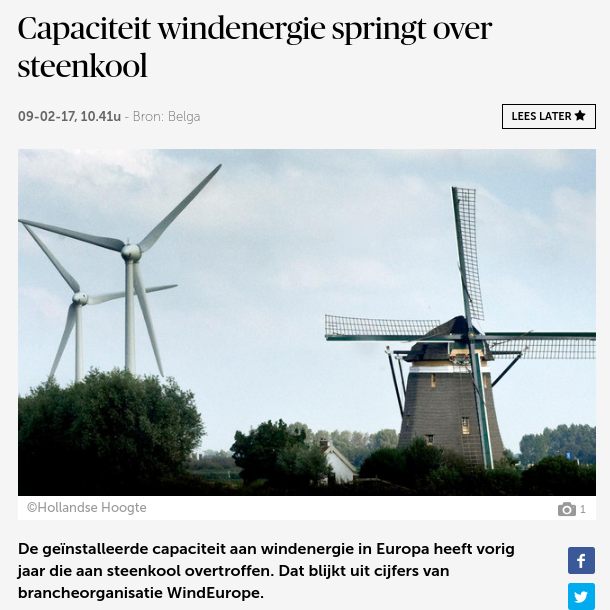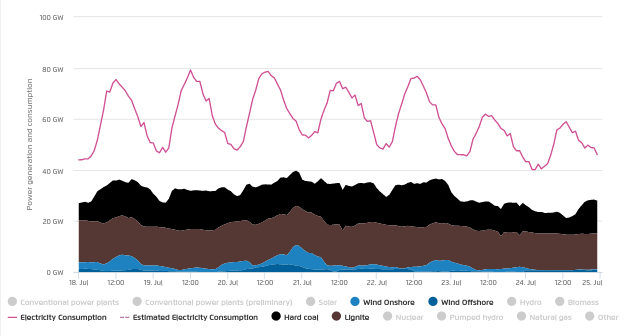From the half-news department comes the article titled Capacity of wind energy has overtaken coal in De Morgen (the Flemish Guardian).

This is how it is explained (translated from Dutch):
Last year, the installed capacity of wind power in Europe surpassed that of coal. This according to figures from the industry association WindEurope.
In terms of capacity, only gas-fired power plants preceded wind energy.
The source was an article with the same title from Belga (a news agency) and it was copied verbatim by a huge flock of news sites in Flanders.
The article in De Morgen jumped out as a sore thumb: it appeared in the section “Science”. Probably copied by a “science” journalist who had no clue that comparing installed capacity of wind with coal is meaningless and a direct comparison of the two is misleading.
After some searching, I found the original source: a report compiled by WindEurope, with the catchy title: Wind in power: 2016 European statistics. “Europe” in fact being the “European Union”, but with also some mentions of Turkey. I found the numbers behind this claim on page 15:

The statement that the installed capacity of wind surpassed that of coal is mathematically correct. Natural Gas came on top (20.3%), followed by wind (16.7%) which did marginally better than coal (16.3%). Therefor Belga could rightfully conclude that installed capacity of Wind energy surpassed that of coal, only preceded by natural gas.
So far, so good.
However, direct comparison of installed capacity of wind and coal is meaningless. There is a big difference how coal-fired turbines work compared to wind turbines. A coal-fired turbine can deliver its capacity as long as someone shovels coal into it, while a wind turbine only delivers when there is (enough) wind. This comes to on average only 20-25% of its capacity. Calculated from the numbers that I found in the report, it was about 22% in 2016 for the EU.
This makes the comparison misleading, since this statement will give the perception that electricity generation by wind is currently on par with that of coal, even a tad higher. This is not the case. Although the installed capacity of wind surpassed the installed capacity of coal, electricity generation by wind will be lower than by coal.
The report mentions the electricity generation figures of wind in 2016, but not that of coal. So it was not possible to check whether this is the case in practice. However, the report mentioned that 44% of the capacity of wind energy was installed in one country: Germany. Installed capacity in Germany in 2016 was 49.64 MW for wind and 49.28 MW for coal. Wind just surpassed coal in Germany too, similar to the EU.
Luckily, the Germans have a nice tool that monitors their electricity generation. This is the current electricity generation of wind compared to coal according to the Agorameter (wind in light/dark blue, coal in brown/black):

Although the installed capacity of coal is slightly less than wind, it generates by far more electricity. It is winter now, maybe the situation was different in summer? This is a week in the middle of July 2016:

Seems rather similar. This example shows why this direct comparison of wind/coal is misleading. Electricity generation by wind will be perceived almost five times higher than it is in reality.
Back to the report. This is how the executive summary started (my emphasis):
Europe installed 12.5 GW of gross additional wind capacity in 2016. This was 3% less than the new installations in 2015. With a total installed capacity of 153.7 GW, wind energy now overtakes coal as the second largest form of power generation capacity in Europe.
The authors drove the message home in graph 1 (the “cumulative power generation capacity” of the different power sources). There were four distinct hooray moments for wind:

Apparently, wind overtook fuel oil in 2007, nuclear in 2013, hydro in 2015 and finally coal in 2016. All of those are distinctly different from wind. Suppose that we would redraw the graph to show electricity generation (that is the way the target audience would understand it), then there probably wouldn’t be a hooray moment for wind yet. coming close to overtake fuel oil. Solar energy (with a capacity factor of about 15%) wouldn’t even come close of overtaken anything.
Concluding, although the statements in the article of Belga are mathematically correct, installed capacity is an utterly meaningless metric when comparing a conventional with an intermittent energy source, especially when not explaining the fundamental difference between the two.

Wishful thinking. And also, beware of that which you wish for: See the experience of South Australia, for example.
LikeLike
I think it is more than just wishful thinking. The authors of the Belga article are probably not aware that wind/solar are fundamentally different from the conventional sources and therefor could not be compared looking at the installed capacity. The same with the many news sites that copied the Belga article verbatim.
I am more puzzled by the authors of the WindEurope report. I can’t imagine that they are not aware that this comparison is meaningless. Yet they created a graph with those four distinct hooray moments based on the installed capacity. Weird. I assume the report is just intended as PR for wind energy.
As I understand the situation in South Australia, it had something to do with a (predictable) lack of wind energy during a heat wave. My next post will be about something similar: whether there is more production of electricity by wind in winter than in summer. An Dutch energy expert said that this was the case, meaning that wind complements solar in that regard (in summer there is a lot of solar energy being produced, in winter much less). In that post, I will try to figure out to what extent wind and solar “complement” each other in winter.
LikeLiked by 1 person
This is the problem with the whole “debate” over renewables. Nameplate capacity is almost meaningless, and it is impossible to reasonably compare averaged output of renewables because they vary so wildly. Think about that chart. The very fact that someone would compare nameplate capacity of renewables to dispatchable power sources implies one of two things, outright intent to deceive or complete and utter incompetence/ignorance on the issue. There is no middle ground because they simply cannot be compared.
The same goes for average output, but to a lesser extent. When you look at what we need verses what renewables offer, you immediately see why we turned away from all but hydro and trivial amounts of biomass…renewables are unsuitable for our needs. Without being paired with enormous amounts of storage capacity, literally pushing into petawatt hours, we will suffer random, catastrophic collapse of the system. And sadly, the most cost effective way we have of dealing with that at the moment is to make vast, lined, underground storage tunnels…turn the majority of the renewable output into hydrogen, and burn it in conventional gas turbines to generate energy. Everything else costs too much, takes too much in materials, or has an impractical footprint in most areas (like pumped storage)
LikeLike
That is indeed the gist of the story. It is misleading to compare installed capacity of intermittent energy sources with that of dispatchable power sources.
Agreed that a non-continuous use of wind power makes more sense than to use it for electricity production.
LikeLike
Looking forward to the next post!
LikeLike
“A coal-fired turbine can deliver its capacity as long as someone shovels coal into it, while a wind turbine only delivers when there is (enough) wind. ”
Even the basis you use for comparison to get to 22% of rated capacity probably overstates it’s real value. When power is not needed, they can stop shoveling coal (and presumably they do), but the wind does not stop blowing. If a significantly larger portion of wind generation occurs when it is not required, thus having no real value, even 22% of rated capacity overstates it’s effective contribution.
LikeLike
I calculated the load factor of wind to show that production by the two sources is different. You are right of course that this is not the whole story. Whether the production was at a time it was needed, is indeed an entirely different story. As is for example the decrease of efficiency when conventional power sources have to cycle up and down to follow the injection of an intermittent power source on the grid. But these are not important to understand the issue I described in this post.
LikeLike
I got in brief discussion over on ARS Technica (where of course facts were downvoted for being inconvenient) trying to explain why the wind simply does not deliver as promised. One guy actually dared to compare the “capacity factors” of things like peaking plants, which (as you pointed out) are capable of running as long as you shove fuel into it…to wind. I tried to point out that this was like comparing an intermittently functional (ie, usually non-functional) car to a normal car that just isn’t driven constantly because the owner doesn’t need to.
The mental gymnastics these people were willing to go through is astonishing. People fail to see that if you are required to have backup power like a conventional/nuclear power plant…then the only way wind could save is if it produces energy for less than the cost of the fuel. And it was beyond their comprehension that some people/businesses might want to forgo the greatly increased complexity entirely even if there was a small savings, and concentrate on delivering a reliable service.
LikeLike